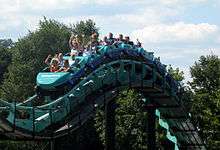Air time (rides)
In the context of amusement rides, air time, or airtime, refers to the time during which riders of a roller coaster or other ride experience either weightlessness or negative G-forces.[1] With roller coasters, air time is usually achieved when the train travels over a hill at speed.

In 2001 the Guinness World Records recorded Superman: Escape from Krypton, located at Six Flags Magic Mountain, Valencia, California, USA, one of the fastest roller coaster in the world, where riders experienced a then record 6.5 seconds of 'airtime' or negative G-force.[2] Hypercoasters, such as Magnum XL-200 at Cedar Point, Behemoth at Canada's Wonderland, Superman the Ride at Six Flags New England, Shambhala at PortAventura Park and Goliath at Six Flags Over Georgia, along with many wooden roller coasters, such as Balder at Liseberg, The Voyage at Holiday World in Santa Claus, Indiana, and El Toro at Six Flags Great Adventure in Jackson, New Jersey, are rides known for having a particularly high total air time. Upon opening in 2018 at Cedar Point, Steel Vengeance, the world's tallest and fastest hybrid coaster, set the record for the most airtime on a roller coaster at 27.2 seconds.
Physics
Air time is a result of the effects of the inertia of the train and the riders: as the train goes over a hill transitioning from an ascent into a descent guided by the rails, the inertia of the relatively loosely-attached riders causes them to momentarily continue upwards, resulting in the riders being lifted out of their seats. The duration of air time on a particular hill is dependent on the velocity of the train, gravity, and the radius of the track's transition from ascent to descent. Zero-G (where the net vertical G-force is 0) is achieved when the downward acceleration is equal to that of gravity; where the downward acceleration is greater, negative Gs arise.
The zero-gravity roll is a roll specifically designed to create the effect of weightlessness and thereby produce air time.
For rollercoasters there are multiple types of air time:
- 1G to 0G: Float (or Floating Air Time)
- 0G: Weightless
- 0G to -1G: Air Time
- −1G and lower: Ejector Air Time
As well as rollercoasters, drop towers can provide the feeling of weightlessness. For example, in the case of The Twilight Zone Tower of Terror at Disney's Hollywood Studios, Disney California Adventure, Tokyo DisneySea, and Disneyland Paris, the elevator drops riders faster than gravity normally would, causing them to rise off of their seats by several inches whilst being held down by only a seat belt, creating the sensation of zero-G. Most drop towers, however, have shoulder bars, preventing riders from rising significantly from their seats, even where negative Gs are present.
The motion-simulator ride Mission: SPACE at EPCOT also includes the sensation of weightlessness after takeoff, just as one enters space.
References
- U.S. News & World Report - Volume 127, Issues 1-8 - Page 66 1999 -"In search of lost whirls Touring America's retro amusement parks where children have visited Gepetto's workshop and the Old Lady ... "All of that air time, minimal restraints— there's just nothing like the Jack Rabbit anymore," he gushes. "
- Guinness World Records 2001- Page 86 "Superman The Escape, located at Six Flags Magic Mountain, Valencia, California, USA, is the fastest roller coaster in the world. They experience a record 6.5 seconds of 'airtime'. or negative G-force."